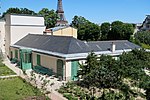Musée de Radio France

The Musée de Radio France was a museum operated by Radio France and located in the Maison de Radio-France, near the Pont de Grenelle in the XVIe arrondissement at 116, avenue du Président Kennedy, Paris, France. The museum was established in 1966, and contained a remarkable collection of radios and televisions from their origins to the present day, including the 1793 telegraph by Claude Chappe and early crystal radios. The museum's 2000 objects include prototypes and commercial devices, archival documents, photographs, and manuscripts, replicas of early radio laboratories and studios, and exhibits featuring research by Edouard Branly, Lee de Forest, Heinrich Hertz, Guglielmo Marconi, James Clerk Maxwell, and Alexander Stepanovich Popov. In 2007, the museum was closed to the public due to the renovation of the Maison de Radio France.
Excerpt from the Wikipedia article Musée de Radio France (License: CC BY-SA 3.0, Authors, Images).Musée de Radio France
Avenue du Président Kennedy, Paris 16th Arrondissement (Paris)
Geographical coordinates (GPS) Address Phone number Website Nearby Places Show on map
Geographical coordinates (GPS)
| Latitude | Longitude |
|---|---|
| N 48.8525 ° | E 2.2783 ° |
Address
Radio France - Maison de la Radio
Avenue du Président Kennedy 116
75220 Paris, 16th Arrondissement (Paris)
Ile-de-France, France
Open on Google Maps








